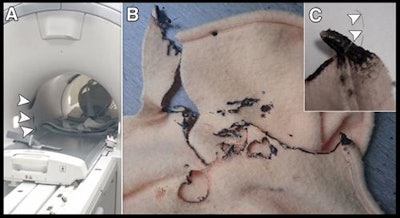
French researchers are alerting radiology facilities to an incident that occurred in their PET/MRI suite: Copper fibers in a blanket used to cover a patient began to heat up, causing the blanket to smolder and nearly catch fire, according to a case study published August 31 in Radiology.
The researchers believe the incident was caused by a recently implemented manufacturing process that left metal fibers in the hem of the blanket. When combined with the unique way in which the blanket was folded, this created a loop of electrical current that began to heat up during the scan (Radiology, August 31, 2017).
 Sequence of images shows the following: (A) Smoke damage inside PET/MRI scanner, (B) combustion of blanket, and (C) small copper filaments believed to have caused the incident. Image courtesy of Radiology.
Sequence of images shows the following: (A) Smoke damage inside PET/MRI scanner, (B) combustion of blanket, and (C) small copper filaments believed to have caused the incident. Image courtesy of Radiology.MRI practitioners take careful steps to ensure that patients are free of metal-containing devices, clothes, or jewelry before their scans. But MRI magnets are so powerful that even trace elements of metal can create a safety hazard, such as with microfiber undershirts made with silver particles or certain kinds of tattoo ink.
In the Radiology paper, a team led by first author Dr. Anne Bertrand, PhD, and senior author Dr. Didier Dormont, PhD, at AP-HP Hôpital Universitaire Pitié-Salpêtrière in Paris described how a 62-year-old woman was prepared for her PET/MRI exam in August 2016. After she was injected with FDG, she was placed in a room for 30 minutes with a blanket to maintain a normal body temperature -- an important consideration given the propensity of FDG to accumulate in brown adipose tissue if a patient's body temperature drops, the authors noted.
The woman was then transferred to the PET/MRI suite and was positioned with her arms alongside her body and her legs side by side, the authors wrote. Next, a large 50-cm restraining strap was placed around her body, and the blanket was placed on top of that.
The PET/MRI scan then began and proceeded for 20 minutes with a routine protocol. A technologist entered the room at end of the exam and noticed a "strong burning odor related to the combustion of the blanket, which she quickly removed from the patient." Fortunately, the patient did not experience any skin burns because she was protected by the strap, the authors noted.
When inspecting the blanket, hospital staff discovered copper filaments; further investigation revealed they were left inside the hem of the blanket during the manufacturing process. The hospital's blanket supplier has been the same French company for the past 15 years, but the researchers discovered that it had recently changed its manufacturing process -- and the technique was also being used by other blanket manufacturers. The group then inspected older blankets at the hospital and didn't find any copper fibers.
Hospital staff notified the blanket manufacturer of the incident, and the company modified its production line to eliminate the use of copper fibers. Technologists and radiologists at the hospital were also notified and told to stop using blankets on patients inside MRI scanners. Finally, the department sent an alert to the French National Agency for Medicines and Health Products Safety.
Bertrand and colleagues closed their review by noting that several unique factors contributed to the incident. In addition to the copper fibers, the blanket was folded in a specific orientation, creating a closed loop that had not occurred in previous exams (the facility had used the PET/MRI scanner for 10 months without incident). Also, the patient had chronic loss of smell and didn't notice the burnt odor coming from the blanket, they wrote.
Still, the incident could have been worse if it weren't for the restraining strap that protected the patient from being burned. One way to avoid future risk is to simply avoid using manufactured blankets, they concluded.
"When isolating the patient from [radiofrequency] coils, disposable linens should be preferred to blankets unless the absence of metallic fiber can be assessed," they wrote.



.fFmgij6Hin.png?auto=compress%2Cformat&fit=crop&h=100&q=70&w=100)




.fFmgij6Hin.png?auto=compress%2Cformat&fit=crop&h=167&q=70&w=250)











